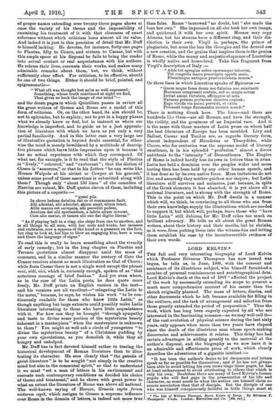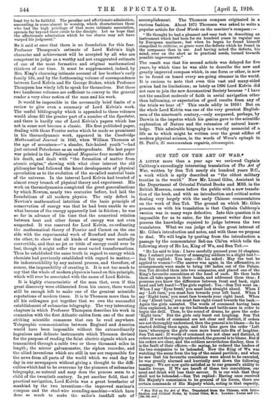LORD KELVIN.*
THE full and very interesting biography of Lord Kelvin which Professor Silvanus Thompson has now issued was begun, he tells us, in June, 1906, with the consent and
assistance of its illustrious subject, who himself furnished a number of personal reminiscences and autobiographical data. Lord Kelvin's death at the end of 1907 "affected the project of the work by necessarily extending its scope to present a much more comprehensive account of his career than the sketch originally planned. The mass of letters, diaries, and other documents which he left became available for filling in the outlines, and the task of arrangement and selection from these greatly extended the period of preparation." Thus the work, which has long been eagerly expected by all who are interested in the fascinating romance—as we may well call it— of the vast evolution of physical science during the last sixty years, only appears when more than two years have elapsed since the death of the illustrious man whose epoch-making discoveries and achievements it relates. This delay has had certain advantages in adding greatly to the material at the author's disposal, and the biography as we now have it is an admirable and affectionate piece of work, which clearly describes the adventures of a gigantic intellect :—
"It has been the author's desire to let documents and letters speak as far as possible for themselves ; and if he has not always been able to avoid letting his own views tinge these pages, lie has at least endeavoured to avoid attributing to others that which is only his own. Doubtless there are many of Lord Kelvin's former pupils who will find gaps in the presentation of his life and character, as must needs be when the author can himself claim no nearer association than that of disciple. But the oiisciple of one who was himself conspicuously faithful in little things must at • The Life of WIlliarn Thomeon, Baran Kelvin St Largs. By Silvan= I'. Thompson. 2 TO113. London: Macmillan and Co. 1..:308. net.3
least try to be faithful. The peculiar and affectionate admiration, amounting in some almost to worship, which characterizes those who had the high privilege of that more intimate association, spreads far beyond their circle to the disciple. Let us hope that the affectionate admiration which he too shares may not have warped his judgment."
Be it said at once that there is no foundation for this fear. Professor Thompson's estimate of Lord Kelvin's high character and achievement will be accepted by all who are
competent to judge as a worthy and not exaggerated estimate of one of the most formative and original mathematical thinkers of our time. It must be supplemented, indeed, by Mrs. King's charming intimate account of her brother's early family life, and by the forthcoming volume of correspondence between Lord Kelvin and Sir George Stokes, which Professor Thompson has wisely left to speak for themselves. But these two handsome volumes are sufficient to convey to the general reader a very clear notion of the man and his work.
It would be impossible in the necessarily brief limits of a review to give even a summary of Lord Kelvin's work.
The useful bibliography which is appended to these volumes would alone fill the greater part of a number of the Spectator, and there is hardly one of Lord Kelvin's papers which has not in some sort become a classic. His first published paper, dealing with those Fourier series which he made so prominent in his thermodynamic work, appeared in the Cambridge Mathematical Journal in 1841, when William Thomson at the age of seventeen—" a slender, fair-haired youth "—had just entered Peterhouse as an undergraduate. His last paper was printed in the Philosophical Magazine four months after his death, and dealt with "the formation of matter from atomic origins," showing with what close interest the old philosopher had followed the latest developments of physical speculation as to the evolution of the so-called material basis of the universe. In the interval Lord Kelvin had treated of almost every branch of physical theory and experiment. His work on thermodynamics completed the great generalisations by which Newton, nearly two centuries before, had laid the foundations of all modern physics. The only defect in Newton's mathematical intuition of the basic principle of conservation of energy was that be had been unable to see what became of the energy apparently lost in friction ; he was so far in advance of his time that the numerical relation between heat and other forms of energy was not even suspected. It was reserved for Lord Kelvin, co-ordinating the mathematical theory of Fourier and Carnot on the one side with the experimental work of Rumford and Joule on the other, to show that all kinds of energy were mutually convertible, and that no jot or tittle of energy could ever be lost, though it might suffer the most varied transformations.
Thus he established the same truth in regard to energy which chemists had previously established with regard to matter,—
its indestructibility by any natural process, and therefore, of course, the impossibility of creating it. It is not too much to say that the whole of modern physics is based on this principle, which will ever be associated with the name of Lord Kelvin.
It is highly characteristic of the man that, even if this great discovery were obliterated from his career, there would still be enough left to make one of the greatest scientific reputations of modern times. It is to Thomson more than to all his colleagues put together that we owe the successful establishment of submarine telegraphy. The very interesting chapters in which Professor Thompson describes his work in connexion with the first Atlantic cables form one of the most striking scientific romances that can be read anywhere. 'Telegraphic communication between England and America would have been impossible without the extraordinarily ingenious and delicate instruments which Thomson devised for the purpose of reading the faint electric signals which are transmitted through a cable two or three thousand miles in length ; the mirror galvanometer, the siphon recorder, and the allied inventions which are still in use are responsible for the news from all parts of the world which we read day by day in our newspapers without giving a thought to the diffi- culties which had to be overcome by the pioneers of submarine telegraphy, so natural and easy does the process seem to a child of the twentieth century. In yet another field, that of practical navigation, Lord Kelvin was a great benefactor of mankind by the two inventions—the improved mariner's compass and the steel-wire sounding-machine—which have done so much to make the sailor's landfall safe of accomplishment. The Thomson compass originated in a curious fashion. About 1871 Thomson was asked to write a popular article for Good Words on the mariner's compass :—
"He thought he had a pleasant and easy task in describing an instrument which had been for six hundred years in regular use by European mariners ; but when he began he found himself compelled to criticise, so grave were the defects which he found in the compasses then in use. And having noted the defects, his mind, ever on the alert as to practical needs, turned towards possible improvements."
The result was that his second article was delayed for fire years, by which time he was able to describe the new and greatly improved compass which, in one form or other, is now to be found on hoard every sea-going steamer in the world.
It is curious to note that even this vast and many-sided genius had its limitations; as lately as 1896 Lord Kelvin did not care to join the new Aeronautical Society because "I have not the smallest molecule of faith in aerial navigation other than ballooning, or expectation of good results from any of the trials we hear of." This reads oddly in 1910! But on. the whole Lord Kelvin was one of the very greatest English- men of the nineteenth century,—only surpassed, perhaps, by Darwin in the impetus which his genius gave to the scientific exploration of Nature and the extension of natural know- ledge. This admirable biography is a worthy memorial of a life as to which might be written over the great edifice of modern physical science, in the words of Wren's epitaph in St. Paul's, Si monumenteum reguiris, circumspice.











































 Previous page
Previous page